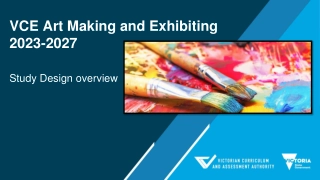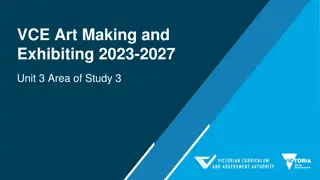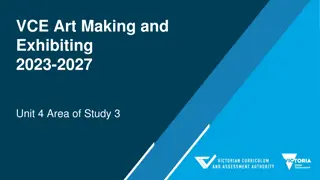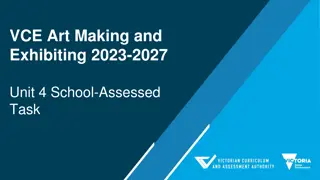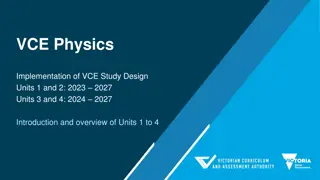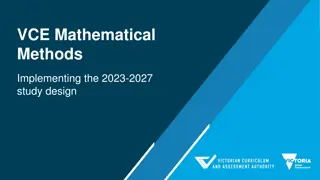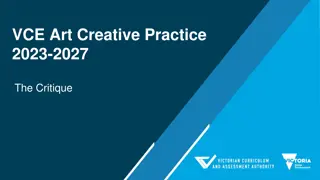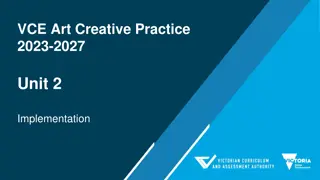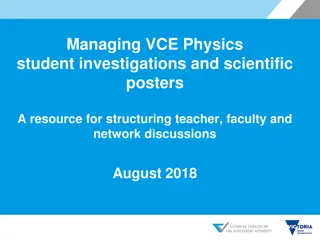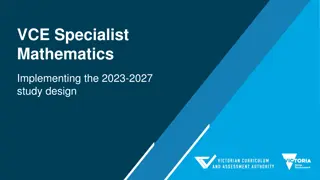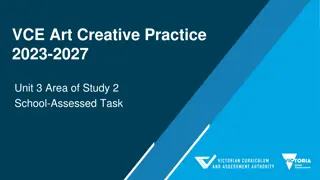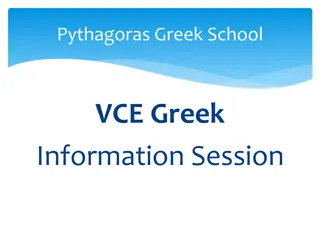VCE Art Making & Exhibiting: The Critique Overview
This presentation delves into the role of the Critique in VCE Art Making & Exhibiting, focusing on structuring, presenting, and utilizing feedback. Understand how a critique enhances awareness and evaluation of artistic characteristics.
Uploaded on Feb 27, 2025 | 0 Views
Download Presentation

Please find below an Image/Link to download the presentation.
The content on the website is provided AS IS for your information and personal use only. It may not be sold, licensed, or shared on other websites without obtaining consent from the author.If you encounter any issues during the download, it is possible that the publisher has removed the file from their server.
You are allowed to download the files provided on this website for personal or commercial use, subject to the condition that they are used lawfully. All files are the property of their respective owners.
The content on the website is provided AS IS for your information and personal use only. It may not be sold, licensed, or shared on other websites without obtaining consent from the author.
E N D
Presentation Transcript
VCE Art Making and Exhibiting 2023-2027 The Critique
VCE Art Making and Exhibiting The Critique Overview This presentation will cover: The role of the Critique in VCE Art Making and Exhibiting Units that focus on the Critique Structuring a critique Presenting the critique Using feedback from the critique
VCE Art Making and Exhibiting The Critique A critique is a discursive collaborative environment that is organised to engage, explore, express, present and evaluate artworks and to understand, reflect on and improve awareness of the characteristics of art making. Terms used in the Study p. 15 VCE Art Making and Exhibiting Study Design
VCE Art Making and Exhibiting The Critique Unit 3 Area of Study 2 In order to receive constructive feedback on the progress of their art making, and to develop and extend their ideas, students present a critique of their artworks to their peer group. Students show a selection of their developmental work and artworks from their Visual Arts journal in their presentation. After the critique students evaluate their work and revise, refine and resolve their artworks
VCE Art Making and Exhibiting The Critique Unit 3 Area of Study 2 Outcome 2 On completion of this unit the student should be able to make artworks in specific art forms, prepare and present a critique, and reflect on feedback. Key Knowledge methods used to prepare and present a critique how to use feedback to revise and further develop artworks in specific art forms art terminology and visual language used in the documentation, presentation, reflection and evaluation of artworks and art making. Key Skills prepare and present a critique describing and evaluating the making of artworks document and reflect on feedback from a critique to revise and further develop artworks use art terminology and visual language in documentation, presentation, reflection and evaluation of artworks and art making
VCE Art Making and Exhibiting The Critique Assessment Unit 3 Outcome 2 Students present their Unit 3 art making in a critique to their class or other group. They include all aspects of Outcomes 1 and 2. The presentation is limited to 10 pages from their Visual Arts journal and at least TWO artworks. Students gather feedback from the critique and reflect on it to further develop artworks in Unit 4. The reflection on the feedback must be documented in 1000 1500 words, with visual information. The presentation can be conducted in one of the following formats: an oral or written presentation with supporting visual evidence an annotated visual report an annotated poster or display a publication, either in hard copy or online, with written and visual material a presentation in a digital format, such as an online presentation or video, with written and visual material.
VCE Art Making and Exhibiting The Critique Unit 4 Area of Study 2 In this area of study students present and critique their finished artworks. From their research of exhibitions and spaces where artworks are displayed, students plan their presentation for a specific space. Students select an exhibition space that complements the ideas in their finished artworks. Students present a short overview statement about the finished artworks and their intentions, as didactic information. The statement also forms the preparation work for the critique, where students discuss the subject matter and ideas developed in their finished artworks, their use of visual language, and the materials, techniques and processes used to make the artworks. The presentation of the finished artworks is discussed in a critique. The critique is a record of the student s thinking and art making. A key aim of the critique is to make explicit the decisions throughout art making, including the development of ideas and use of visual language and the resolution and refinement of their finished artworks. Students present their artworks to a group and reflect on written or verbal feedback.
VCE Art Making and Exhibiting The Critique Unit 4 Outcome 2 On completion of this unit the student should be able to plan and display at least one finished artwork in a specific art form, and present a critique. Key Knowledge methods used to prepare and present a critique of art making and at least one finished artwork in a specific art form methods used to critically evaluate art making in a critique methods used to explain decisions made throughout art making in a critique methods used to present the representation of subject matter and ideas and the communication of meaning in at least one finished artwork in a specific art form art terminology used in discussion and evaluation of the presentation of a finished artwork in a specific art form and art making in a critique Key Skills present and evaluate at least one finished artwork in a specific art form in a critique prepare and present a critique of art making critically evaluate art making in a critique explain decisions made throughout art making in a critique present and explain the representation of subject matter and ideas and the communication of meaning in at least one finished artwork in a specific art form apply art terminology used in discussion and evaluation of the presentation of at least one finished artwork in a specific art form and art making in a critique
VCE Art Making and Exhibiting The Critique Assessment Unit 4 Outcome 2 School-assessed Task Students present a display and critique of at least one finished artwork to their peers or another group. For the task they: document the planning for the display of at least one finished artwork display at least one finished artwork, considering the specific exhibition space discuss their art making discuss the representation of subject matter and ideas and communication of meaning in at least one finished artwork reflect on written or verbal feedback from the critique.
VCE Art Making and Exhibiting The Critique Teaching and learning activities At the start of the unit/year, make students aware that they will need to prepare a presentation to share with the class as a critique. Ultimately, a critique should seek to renew each student s enthusiasm, energy, confidence and sense of accomplishment. Hallmarks of a critique that will benefit Art Making and Exhibiting students include: establishing a safe, supportive and non-threatening environment listening to each other and engaging in conversation about art making collecting multiple and diverse perspectives about the interpretation of their artwork and its meanings how ideas and meanings are communicated to an audience through the visual language of their artwork identifying strengths and opportunities for improvement in each artwork. Share examples of critiques with the students so they become familiar with the idea of what they need to do in a critique. There are videos that students can review on platforms such as YouTube (search for art critique ). To help students become familiar with the idea, it might be helpful to set up lower-stake tasks during Unit 3 where they present experiments and trials to the class or in small groups for feedback and discussion.
VCE Art Making and Exhibiting Preparing for the Critique Consider the personal involvement the student has in the work. Is there a narrative intent? Is the work representational? Do the formal elements come together to inform the narrative? What were the ideas that led the student to make the work? The critique should have a statement of intent, history of process, interview or format surrounding the work. The student should be able to articulate what they did in relation to their intention. What skills did they employ? The student should also have an ideological perspective or view with their work. The class can think about the work in relation to the artist s intent.
VCE Art Making and Exhibiting Presenting the critique Students should introduce the work, discuss what was critical in the making of it that contributes to the meaning of the work. The student should be able to differentiate between the representation of ideas and communication of meaning in the work. The student should focus on asking questions to the audience, not just on explanations. The group can write some notes about the work before the verbal exchange occurs. Participants could be provided with questions to ask or to answer. These could be collated and given to the student. Questions that could be asked during the critique are found in the Support Material
VCE Art Making and Exhibiting The Critique Gathering and reflecting on feedback The student should take advice from the critique in an active way, not a reactive way. Through active critique the student can justify the alternatives available to them. Feedback from the critique must be supported with evidence. The student can take their own notes or receives notes from the teacher or their peers. Then the student can reflect on the feedback to confirm or reject what they might already know. Students can also identify contradictory comments.
VCE Art Making and Exhibiting Resolving the body of work from the Critique Post Critique Collate the feedback collected during the critique. In your Visual Arts journal, consider the following questions and write a brief evaluation: How effectively did the critique help to clarify the communication of ideas to the audience? Did the audience identify new information or recommendations that you could utilise? How has your art making and your visual language developed since the start of the inquiry? What will you do differently to improve your art making and to resolve the finished artwork?
Contact Dr Kathryn Hendy-Ekers Curriculum Manager Visual Arts, Visual Communication Design and Media E: Kathryn.Hendy-Ekers@education.vic.gov.au T: 9059 5147 M: 0438471513


